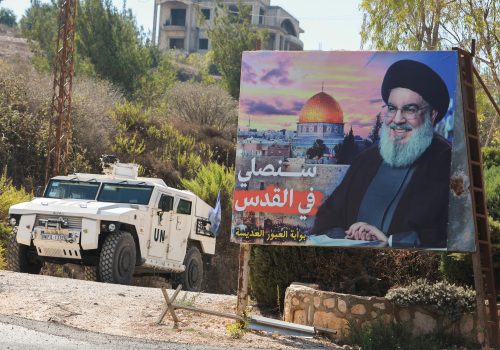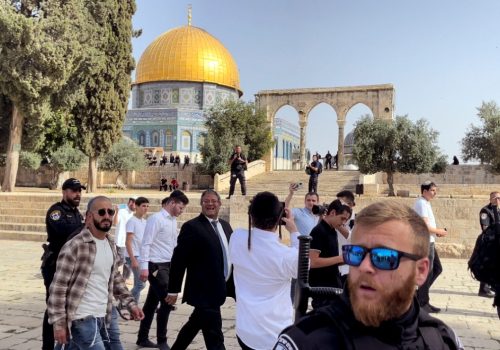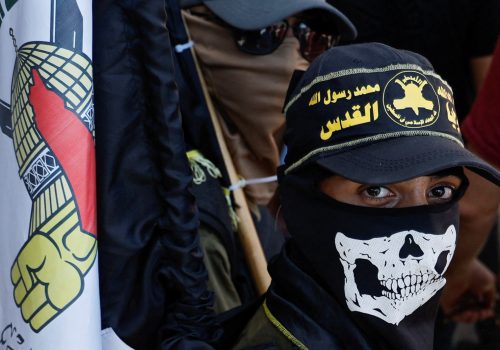Hamas’s attack on Israel was straight out of Hezbollah’s playbook
Israel is a country tragically all too familiar with violence and warfare. But even in the bloody annals of the Jewish state, October 7, 2023, is and will likely remain a unique wound. The images of murdered civilians strewn in the streets of the towns surrounding the Gaza Strip intertwining with the cries of abducted children being carted off into the Hamas-controlled enclave will haunt the Israeli national psyche—and all people of conscience—for decades. But as much as Hamas is ultimately responsible for the perfidious attack that has claimed more than 1,200 lives in Israel, the group could not have planned or executed this operation alone.
Hamas has long ceased to be a lone militant organization. Since 2018, the group has officially operated as a first among equals of the twelve-member “Joint Operations Room of the Palestinian Resistance Factions,” an entity whose technical genesis stretches back to 2006. Indeed, judging from the headbands worn by some of the assailants who infiltrated southern Israel, these other factions were well represented among the attackers. More broadly, since the 1990s Hamas has been gradually integrated into the Iranian-led “Resistance Axis,” a regional network of anti-Israel political parties and militant groups. Among Tehran’s constellation of forces, Hezbollah has taken point on coordinating the Khomeinist regime’s relationship with its Palestinian proxies, and the Shia group’s fingerprints can be detected all over this week’s attack on Israel.
For years, Hezbollah has been promising to “liberate the Galilee” in a future war with Israel. Hezbollah’s secretary-general, Hassan Nasrallah, stated this objective in a February 2011 speech, and the group has conducted exercises simulating the execution of this promise since then. At different times, Hezbollah threatened that it would launch a traditional invasion, meant to seize and permanently hold territory. But such a conventional military maneuver was then, and remains, beyond the group’s capabilities. Such an action would require Hezbollah to establish static supply lines and expose massive numbers of its fighters on Israeli territory, where the Israel Defense Forces (IDF) would possess the numerical and qualitative advantage, in addition to armor, artillery, and air power. In other words, Hezbollah would be discarding the advantages conferred by its hybrid-guerilla warfare methods, without developing the conventional methods or doctrine necessary to match or neutralize the IDF’s vast superiority in conventional warfare.
It would appear, then, that Hezbollah imparted its plans, and the training to execute them, to its Resistance Axis partners in the Gaza Strip.
What, then, would the intended invasion of the Galilee have looked like? Precisely how Hamas’s October 7 attack, dubbed Operation Al-Aqsa Flood, unfolded: a territorially limited surprise incursion, focused on murdering and kidnapping as many Israelis as possible, and capturing the attack on video to maximize the psychological impact on Israeli society and to boost the morale of the supporters of the “resistance.” It would appear, then, that Hezbollah imparted its plans, and the training to execute them, to its Resistance Axis partners in the Gaza Strip. In fact, Hezbollah appears to have shared this knowledge with Hamas and other Gaza-based militant groups at least a decade ago: Israeli security sources noted that the IDF launched 2014’s Operation Protective Edge to preempt exactly such a mass casualty scenario that had been planned by Hamas for that year’s Rosh Hashanah.
Hezbollah appears to have contributed more to the execution of Al-Aqsa Flood than the operational blueprint. The Shia group—constrained in its direct ability to attack Israel by Lebanon’s economic collapse, and not wanting to be seen as compounding Lebanese misery with a security conflagration—has effectively exported its attacks against Israel to Palestinian actors, both within Israel and Israeli-held territories, and from inside Lebanon. Either working directly with Iran’s Islamic Revolutionary Guard Corps (IRGC) or separately at its behest, Hezbollah has spent considerable efforts recruiting assets inside Israel—from among Arab Israelis and Palestinians—to gather intelligence and establish sleeper cells within Israel to plan terror attacks. Here, Hezbollah’s ties to Lebanese and Arab Israeli criminal networks have proven invaluable.
The Shia organization has also spent the past eighteen years building up the warfighting capabilities of militant groups in the Gaza Strip. This effort began in earnest after Israel’s 2005 withdrawal from the Gaza Strip, when Hezbollah’s then-military commander Imad Mughniyeh spent months training Palestinian militants in a coastal enclave. This training included producing rockets and launching pads, as well as tunnel and rocket warfare. Credible reporting—and the admissions of Hamas spokesmen—also reveals that the inception of this particular attack occurred months ago in Beirut, in coordination with the IRGC, but also doubtlessly under the watchful eye and with the input of Hezbollah.
The genesis of Operation Al-Aqsa Flood appears to originate with Hezbollah, at least in part. The pressing question now is what will Hezbollah do next?
So far, Hezbollah’s actions have differed little from the group’s prior behavior during fighting between Gaza-based militants and the IDF, particularly since the October 17, 2019, economic crisis further complicated its ability to act openly or aggressively against Israel. The group has voiced its now customary support for Hamas, stressing the attack on Israel was a message “to the Arab and Islamic world . . . especially those seeking normalization” with the Jewish state (and thus signaling that Hamas’s attack was intended to derail ongoing Saudi-Israeli normalization talks). One of its ad-hoc formations, named after Imad Mughniyeh, conducted a largely symbolic solidarity mortar strike in Shebaa Farms—in other words, in a territory understood by both Hezbollah and Israel as within the red lines governing their conflict. Likely by design, the strike caused no casualties. Israeli forces have exchanged fire with Hezbollah every day since October 7.
If Hamas and its allies find themselves in dire straits against an expected Israeli ground incursion, Iran could deem it necessary to activate Hezbollah.
But otherwise, Hezbollah has so far sat out the fight. It was quick to deny involvement in a Palestinian Islamic Jihad (PIJ) infiltration into northern Israel on October 9. The group’s response to Israel killing three Hezbollah fighters while retaliating for that incursion was also limited and measured. Hezbollah’s promise that this reprisal was only its “preliminary response,” and other belligerent statements, should be taken in the context of similar previously unfulfilled vows to avenge fallen fighters—either to say it will delay avenging them until a time more suitable to Hezbollah or, as happened on October 10, carrying out a limited attack meant to convey the message to the Israelis that the matter is now considered closed.
Furthermore, it should also be understood in the context of its other statements—a promise to Lebanese Foreign Minister Abdullah Bou Habib to abstain from getting involved in the Gaza conflict unless Israel “harasses” Lebanon. Hezbollah spokesman and Lebanese Member of Parliament Ibrahim al-Mousaoui said on Tuesday that Hamas’s operation was a “preview of what the resistance factions will execute in the future.”
The likeliest scenario, therefore, is that Hezbollah will continue to allow Palestinian militants to engage in limited harassment against Israel from Lebanon, thus contributing to Gaza-based militant war efforts by keeping the IDF partially focused on the northern border but without sparking a major conflagration. Hezbollah’s calculus could change, however, as the IDF’s battle against Hamas and the remaining Resistance Axis factions in Gaza progresses. If Hamas and its allies find themselves in dire straits against an expected Israeli ground incursion, Iran could deem it necessary to activate Hezbollah. Alternatively, the Shia organization may already have its orders to enter the war. Its direct and indirect harassment on the northern border may be intended to goad the IDF into a serious enough retaliation that Hezbollah could then use it to justify attacking Israel to its supporters and the broader Lebanese public as an act of self-defense against so-called “Zionist aggression.”
David Daoud is the director of Israel, Lebanon, and Syria Research at United Against Nuclear Iran (UANI) and is a nonresident fellow at the Atlantic Council.
A version of this article originally appeared in United Against Nuclear Iran. It is reprinted here with the author’s and publisher’s permission.
Further reading
Wed, Apr 5, 2023
A series of unrelated events happened in Israel. Fingers are pointing at Hezbollah.
IranSource By David Daoud
Tensions have been unusually high along the Lebanese-Israeli border. But war, or a large-scale conflagration, is not imminent.
Mon, Jan 30, 2023
Ben-Gvir’s controversial new position angered the Arab world. But how will it impact a potential peace deal with Saudi Arabia?
MENASource By Ksenia Svetlova
Will PM Benjamin Netanyahu find the desired equilibrium between the radical politics of his coalition partner and diplomacy with Arab capitals?
Tue, Oct 10, 2023
Hamas’s attack underscores the need for US and Israeli policy to change course
MENASource By
Both Israel and the United States should engage in deep introspection at the policy level over their failure to deter Hamas’s brutal attack.
Image: Lebanese pro-Iranian Hezbollah supporters wave their party flags and the Palestinian flags during a rally in Beirut's southern suburbs to praise the unexpected attack by Hamas militants against Israeli towns and settlements near the Gaza Strip. Hezbollah fired rockets at Israeli-occupied territory from the north on Sunday morning, according to the Israeli army.


